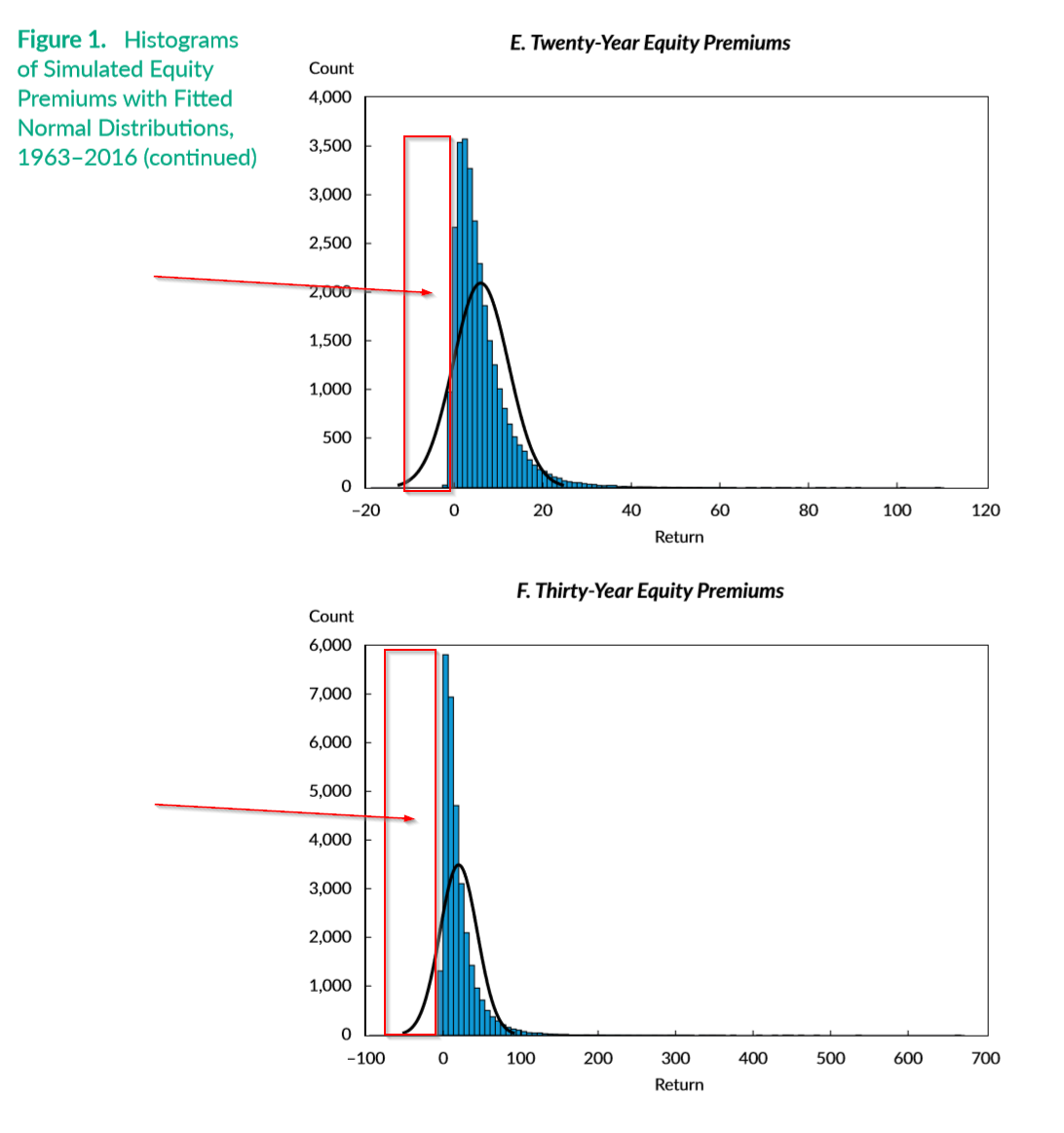Volatility Lessons
- Eugene F. Fama and Kenneth R. French
- Financial Analysts Journal
- A version of this paper can be found here
- Want to read our summaries of academic finance papers? Check out our Academic Research Insight category
What are the research questions?
The purpose of this study was to examine the changes in the distribution of the US equity risk premium as the return horizon varies from monthly, annually, 3 year, 5 year, 10 year, 20 and 30 year periods. The equity premium was calculated as the monthly difference between the Market and Treasury bill returns. Two types of simulations were conducted: (1) the first simulation treated the sample of historical return data as the population; and (2) the second treated the mean of the equity risk premium as uncertain. This volatility around the expected premium was then built into the simulation. The same analysis is conducted for large cap value stocks, small cap value stocks and small cap stocks, although not reviewed here.
- Does the dispersion of the distribution of the equity returns change when the investment horizon is lengthened?
- Is the expected risk premium or mean of the distribution observed to be negative for any holding period?
- Is the probability of a negative equity risk premium substantial at any of the investment horizons?
What are the Academic Insights?
- YES. For the simulation with a known mean, the volatility/SD increased as follows: .04 (1mo HP); .17 (1yr HP); .37 (3yr HP); .59 (5yr HP); 1.49 (10yr HP); 6.58 (20yr HP); 25.52 (30yr HP). For an uncertain mean, the SD increased as follows: .17 (1yr HP); .38 (3yr HP); .63 (5yr HP); 1.67 (10yr HP); 8.70 (20yr HP); 42.39 (30yr HP). The volatility of the risk premium increased as the holding period increases.
- NO. For the simulation with a known mean, the average premium was as follows: . 01 (1mo HP); .07 (1yr HP); .23 (3yr HP); .45 (5yr HP); 1.33 (10yr HP); 6.10 (20yr HP); 21.39 (30yr HP). For an uncertain mean, the average was as follows: .07 (1yr HP); .23 (3yr HP); .46 (5yr HP); 1.40 (10yr HP); 6.85 (20yr HP); 26.69 (30yr HP). As the holding period increased, the expected risk premium also increased, but it shifted to the right at a rate that is faster than the increase in volatility. Therefore, the distribution exhibited a large number of positive outcomes at the extreme right tail.
- YES. In the charts below, it is clear that the distributions relative to the normal, become more peaked and skewed to the right as the holding period is lengthened. And in general, there is a decreasing chance that a negative risk premium will be observed with longer holding periods. That is very good news. However, negative equity premiums do occur at a nontrivial frequency. For the one year period (not shown here), the simulated distribution is very close to normal and the likelihood of a negative return is the highest. Moving to the 3, 5, 10 and 20 year periods there is a declining chance of observing a negative equity risk premium, but it does occur and can be substantial.
Why does it matter?
Volatility Lesson from this research applies directly to the use of 1, 3, 5, 10 and even 20 year holding period historical return data to forecast the equity risk premium. The noise embedded in these short and long term return series make forecasting risk premiums unreliable if these specific holding periods are used as the basis for the forecast. At the 1, 3, and 5 year holding periods, the probability that the equity risk premium could be negative is substantial. Even at the 10 and 20 year periods, the probability of a negative return is low but is nontrivial when observed.
These results call into question the use of this type of data commonly used for asset allocation as well as valuation decisions. The authors conclude with a subtle but deadly warning:
Those who act on such noisy evidence should reconsider their approach.
Wow.
The most important charts from the paper

Abstract
The average monthly premium of the Market return over the one month T-bill return is substantial, as are average premiums of value and small stocks over Market. As the return horizon increases, premium distributions become more disperse, but they move to the right (toward higher values) faster than they become more disperse. There is, however, some bad news. Even if future expected premiums match high past averages, high volatility means that for the 3- and 5-year periods commonly used to evaluate asset allocations, the probabilities of negative realized premiums are substantial, and the probabilities are nontrivial for 10- and 20-year periods.
About the Author: Tommi Johnsen, PhD
—
Important Disclosures
For informational and educational purposes only and should not be construed as specific investment, accounting, legal, or tax advice. Certain information is deemed to be reliable, but its accuracy and completeness cannot be guaranteed. Third party information may become outdated or otherwise superseded without notice. Neither the Securities and Exchange Commission (SEC) nor any other federal or state agency has approved, determined the accuracy, or confirmed the adequacy of this article.
The views and opinions expressed herein are those of the author and do not necessarily reflect the views of Alpha Architect, its affiliates or its employees. Our full disclosures are available here. Definitions of common statistics used in our analysis are available here (towards the bottom).
Join thousands of other readers and subscribe to our blog.


